The Novel Class IIa Selective Histone Deacetylase Inhibitor YAK540 Is Synergistic with Bortezomib in Leukemia Cell Lines
Abstract
1. Introduction
2. Results
2.1. Synthesis of YAK540
2.2. Investigation of Cytotoxicity and HDAC Inhibitory Effect
2.3. Apoptosis Induction and Caspase Activation of Class IIa Inhibitors in Combination with Proteasominhibitor Bortezomib
2.4. Chou-Talalay Synergism Studies in MTT Assays
2.5. Mechanistic Study of Class IIa Inhibitors in Combination with Proteasome Inhibitors
2.6. Selectivity of Class IIa HDACI in Combination with BTZ for Leukemia vs. Non-cancer Cell
3. Discussion
4. Materials and Methods
4.1. Materials
4.2. Cell Lines and Cell culture
4.3. MTT Cell Viability Assay
4.4. Enzyme HDAC Inhibition Assay
4.5. Whole-Cell HDAC Inhibition Assay
4.6. Measurement of Apoptotic Nuclei
4.7. Activation of Caspase 3/7
4.8. Immunoblotting
4.9. RT-PCR
5. Conclusions
Supplementary Materials
Author Contributions
Funding
Institutional Review Board Statement
Informed Consent Statement
Data Availability Statement
Conflicts of Interest
References
- National Cancer Institute. Available online: https://seer.cancer.gov/statfacts/html/leuks.html (accessed on 13 June 2022).
- National Cancer Institute. Available online: https://seer.cancer.gov/statfacts/html/amyl.html (accessed on 13 June 2022).
- National Cancer Institute. Available online: https://seer.cancer.gov/statfacts/html/cmyl.html (accessed on 13 June 2022).
- Howlader, N.; Noone, A.M.; Krapcho, M.; Miller, D.; Brest, A.; Yu, M.; Ruhl, J.; Tatalovich, Z.; Mariotto, A.; Lewis, D.R.; et al. (Eds.) SEER Cancer Statistics Review 1975–2018; National Cancer Institute: Bethesda, MD, USA, 2021; Available online: https://seer.cancer.gov/csr/1975_2018/ (accessed on 13 June 2022).
- European Medicine Agency. Available online: https://www.ema.europa.eu/en/documents/product-information/velcade-epar-product-information_de.pdf (accessed on 13 June 2022).
- Csizmar, C.M.; Kim, D.-H.; Sachs, Z. The Role of the Proteasome in AML. Blood Cancer J. 2016, 6, e503. [Google Scholar] [CrossRef]
- Accardi, F.; Toscani, D.; Bolzoni, M.; Dalla Palma, B.; Aversa, F.; Giuliani, N. Mechanism of Action of Bortezomib and the New Proteasome Inhibitors on Myeloma Cells and the Bone Microenvironment: Impact on Myeloma-Induced Alterations of Bone Remodeling. BioMed Res. Int. 2015, 2015, 172458. [Google Scholar] [CrossRef] [PubMed]
- Meregalli, C. An Overview of Bortezomib-Induced Neurotoxicity. Toxics 2015, 3, 294–303. [Google Scholar] [CrossRef] [PubMed]
- Robak, P.; Robak, T. Bortezomib for the Treatment of Hematologic Malignancies: 15 Years Later. Drugs R&D 2019, 19, 73–92. [Google Scholar] [CrossRef]
- Roeten, M.S.F.; van Meerloo, J.; Kwidama, Z.J.; Ter Huizen, G.; Segerink, W.H.; Zweegman, S.; Kaspers, G.J.L.; Jansen, G.; Cloos, J. Pre-Clinical Evaluation of the Proteasome Inhibitor Ixazomib against Bortezomib-Resistant Leukemia Cells and Primary Acute Leukemia Cells. Cells 2021, 10, 665. [Google Scholar] [CrossRef] [PubMed]
- Kupperman, E.; Lee, E.C.; Cao, Y.; Bannerman, B.; Fitzgerald, M.; Berger, A.; Yu, J.; Yang, Y.; Hales, P.; Bruzzese, F.; et al. Evaluation of the Proteasome Inhibitor MLN9708 in Preclinical Models of Human Cancer. Cancer Res. 2010, 70, 1970–1980. [Google Scholar] [CrossRef]
- Richardson, P.G.; Baz, R.; Wang, M.; Jakubowiak, A.J.; Laubach, J.P.; Harvey, R.D.; Talpaz, M.; Berg, D.; Liu, G.; Yu, J.; et al. Phase 1 study of twice-weekly ixazomib, an oral proteasome inhibitor, in relapsed/refractory multiple myeloma patients. Blood 2014, 124, 1038–1047. [Google Scholar] [CrossRef]
- Moreau, P.; Karamanesht, I.I.; Domnikova, N.; Kyselyova, M.Y.; Vilchevska, K.V.; Doronin, V.A.; Schmidt, A.; Hulin, C.; Leleu, X.; Esseltine, D.L.; et al. Pharmacokinetic, pharmacodynamic and covariate analysis of subcutaneous versus intravenous administration of bortezomib in patients with relapsed multiple myeloma. Clin. Pharmacokinet. 2012, 51, 823–829. [Google Scholar] [CrossRef]
- Kikuchi, S.; Suzuki, R.; Ohguchi, H.; Yoshida, Y.; Lu, D.; Cottini, F.; Jakubikova, J.; Bianchi, G.; Harada, T.; Gorgun, G.; et al. Class IIa HDAC Inhibition Enhances ER Stress-Mediated Cell Death in Multiple Myeloma. Leukemia 2015, 29, 1918–1927. [Google Scholar] [CrossRef]
- Eckschlager, T.; Plch, J.; Stiborova, M.; Hrabeta, J. Histone Deacetylase Inhibitors as Anticancer Drugs. Int. J. Mol. Sci. 2017, 18, 1414. [Google Scholar] [CrossRef]
- Harada, T.; Hideshima, T.; Anderson, K.C. Histone deacetylase inhibitors in multiple myeloma: From bench to bedside. Int. J. Hematol. 2016, 104, 300–309. [Google Scholar] [CrossRef] [PubMed]
- AdooQ Bioscience. Available online: https://www.adooq.com/datasheet?A14128 (accessed on 5 July 2022).
- Turkman, N.; Liu, D.; Pirola, I. Design, synthesis, biochemical evaluation, radiolabeling and in vivo imaging with high affinity class-IIa histone deacetylase inhibitor for molecular imaging and targeted therapy. Eur. J. Med. Chem. 2021, 228, 114011. [Google Scholar] [CrossRef] [PubMed]
- Stott, A.J.; Maillard, M.C.; Beaumont, V.; Allcock, D.; Aziz, O.; Borchers, A.H.; Blackaby, W.; Breccia, P.; Creighton-Gutteridge, G.; Haughan, A.F.; et al. Evaluation of 5-(Trifluoromethyl)-1,2,4-oxadiazole-Based Class IIa HDAC Inhibitors for Huntington’s Disease. ACS Med. Chem. Lett. 2021, 12, 380–388. [Google Scholar] [CrossRef] [PubMed]
- Asfaha, Y.; Schrenk, C.; Alves Avelar, L.A.; Hamacher, A.; Pflieger, M.; Kassack, M.U.; Kurz, T. Recent advances in class IIa histone deacetylases research. Bioorganic Med. Chem. 2019, 27, 115087. [Google Scholar] [CrossRef]
- Lobera, M.; Madauss, K.P.; Pohlhaus, D.T.; Wright, Q.; Trocha, M.; Schmidt, D.R.; Baloglu, E.; Trump, R.P.; Head, M.S.; A Hofmann, G.; et al. Selective class IIa histone deacetylase inhibition via a nonchelating zinc-binding group. Nat. Chem. Biol. 2013, 9, 319–325. [Google Scholar] [CrossRef]
- Di Giorgio, E.; Gagliostro, E.; Brancolini, C. Selective class IIa HDAC inhibitors: Myth or reality. Cell. Mol. Life Sci. 2015, 72, 73–86. [Google Scholar] [CrossRef]
- Bradner, J.E.; West, N.; Grachan, M.L.; Greenberg, E.F.; Haggarty, S.J.; Warnow, T.; Mazitschek, R. Chemical phylogenetics of histone deacetylases. Nat. Chem. Biol. 2010, 6, 238–243. [Google Scholar] [CrossRef]
- Chou, T.-C.; Talalay, P. Quantitative Analysis of Dose-Effect Relationships: The Combined Effects of Multiple Drugs or Enzyme Inhibitors. Adv. Enzym. Regul. 1984, 22, 27–55. [Google Scholar] [CrossRef]
- Di Veroli, G.Y.; Fornari, C.; Wang, D.; Mollard, S.; Bramhall, J.L.; Richards, F.M.; Jodrell, D.I. Combenefit: An interactive platform for the analysis and visualisation of drug combinations. Bioinformatics 2016, 32, 2866–2868. [Google Scholar] [CrossRef]
- Zhao, W.; Sachsenmeier, K.; Zhang, L.; Sult, E.; Hollingsworth, R.E.; Yang, H. A New Bliss Independence Model to Analyze Drug Combination Data. J. Biomol. Screen. 2014, 19, 817–821. [Google Scholar] [CrossRef]
- Vandesompele, J.; De Preter, K.; Pattyn, F.; Poppe, B.; Van Roy, N.; De Paepe, A.; Speleman, F. Accurate Normalization of Real-Time Quantitative RT-PCR Data by Geometric Averaging of Multiple Internal Control Genes. Genome Biol. 2002, 3, RESEARCH0034. [Google Scholar] [CrossRef] [PubMed]
- van Dijk, A.D.; Hoff, F.W.; Qiu, Y.; Gerbing, R.B.; Gamis, A.S.; Aplenc, R.; Kolb, E.A.; Alonzo, T.A.; Meshinchi, S.; Jenkins, G.N.; et al. Bortezomib is significantly beneficial for de novo pediatric AML patients with low phosphorylation of the NF-κB subunit RelA. Proteom. Clin. Appl. 2022, 16, 2100072. [Google Scholar] [CrossRef] [PubMed]
- Hoff, F.W.; van Dijk, A.D.; Qiu, Y.H.; Ruvolo, P.P.; Gerbing, R.B.; Leonti, A.R.; Jenkins, G.N.; Gamis, A.S.; Aplenc, R.; Kolb, E.A.; et al. Heat shock factor 1 (HSF1-pSer326) predicts response to bortezomib-containing chemotherapy in pediatric AML: A COG report. Blood 2021, 137, 1050–1060. [Google Scholar] [CrossRef]
- San José-Enériz, E.; Gimenez-Camino, N.; Agirre, X.; Prosper, F. HDAC Inhibitors in Acute Myeloid Leukemia. Cancers 2019, 11, 1794 . [Google Scholar] [CrossRef]
- Asfaha, Y. Development of Class IIa Histone Deacetylase Inhibitors. Ph.D. Thesis, Universitäts- und Landesbibliothek, Düsseldorf, Germany, 2020. [Google Scholar]
- Gui, C.Y.; Ngo, L.; Xu, W.S.; Richon, V.M.; Marks, P.A. Histone deacetylase (HDAC) inhibitor activation of p21WAF1 involves changes in promoter-associated proteins, including HDAC1. Proc. Natl. Acad. Sci. USA 2004, 101, 1241–1246. [Google Scholar] [CrossRef]
- Journal Onokologie. Available online: https://www.journalonko.de/downloads/herunterladen/fi_velcade_jan2014 (accessed on 8 July 2022).
- Wang, C.; Hamacher, A.; Petzsch, P.; Köhrer, K.; Niegisch, G.; Hoffmann, M.J.; Schulz, W.A.; Kassack, M.U. Combination of Decitabine and Entinostat Synergistically Inhibits Urothelial Bladder Cancer Cells via Activation of FoxO1. Cancers 2020, 12, 337. [Google Scholar] [CrossRef]
- Engelke, L.H.; Hamacher, A.; Proksch, P.; Kassack, M.U. Ellagic Acid and Resveratrol Prevent the Development of Cisplatin Resistance in the Epithelial Ovarian Cancer Cell Line A2780. J. Cancer 2016, 7, 353–363. [Google Scholar] [CrossRef]
- Heltweg, B.; Jung, M. A Microplate Reader-Based Nonisotopic Histone Deacetylase Activity Assay. Anal. Biochem. 2002, 302, 175–183. [Google Scholar] [CrossRef] [PubMed]
- Ciossek, T.; Julius, H.; Wieland, H.; Maier, T.; Beckers, T. A Homogeneous Cellular Histone Deacetylase Assay Suitable for Compound Profiling and Robotic Screening. Anal. Biochem. 2008, 372, 72–81. [Google Scholar] [CrossRef]
- Bonfils, C.; Kalita, A.; Dubay, M.; Siu, L.L.; Carducci, M.A.; Reid, G.; Martell, R.E.; Besterman, J.M.; Li, Z. Evaluation of the Pharmacodynamic Effects of MGCD0103 from Preclinical Models to Human Using a Novel HDAC Enzyme Assay. Clin. Cancer Res. Off. J. Am. Assoc. Cancer Res. 2008, 14, 3441–3449. [Google Scholar] [CrossRef]
- Marek, L.; Hamacher, A.; Hansen, F.K.; Kuna, K.; Gohlke, H.; Kassack, M.U.; Kurz, T. Histone Deacetylase (HDAC) Inhibitors with a Novel Connecting Unit Linker Region Reveal a Selectivity Profile for HDAC4 and HDAC5 with Improved Activity against Chemoresistant Cancer Cells. J. Med. Chem. 2013, 56, 427–436. [Google Scholar] [CrossRef] [PubMed]
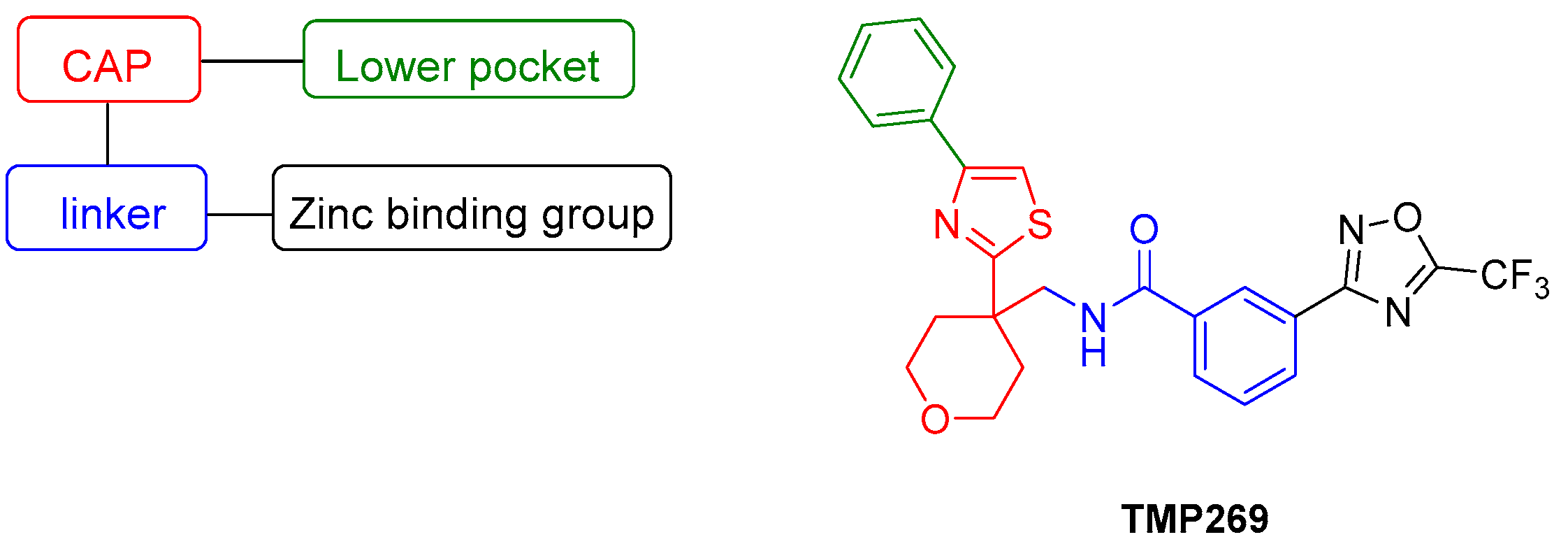


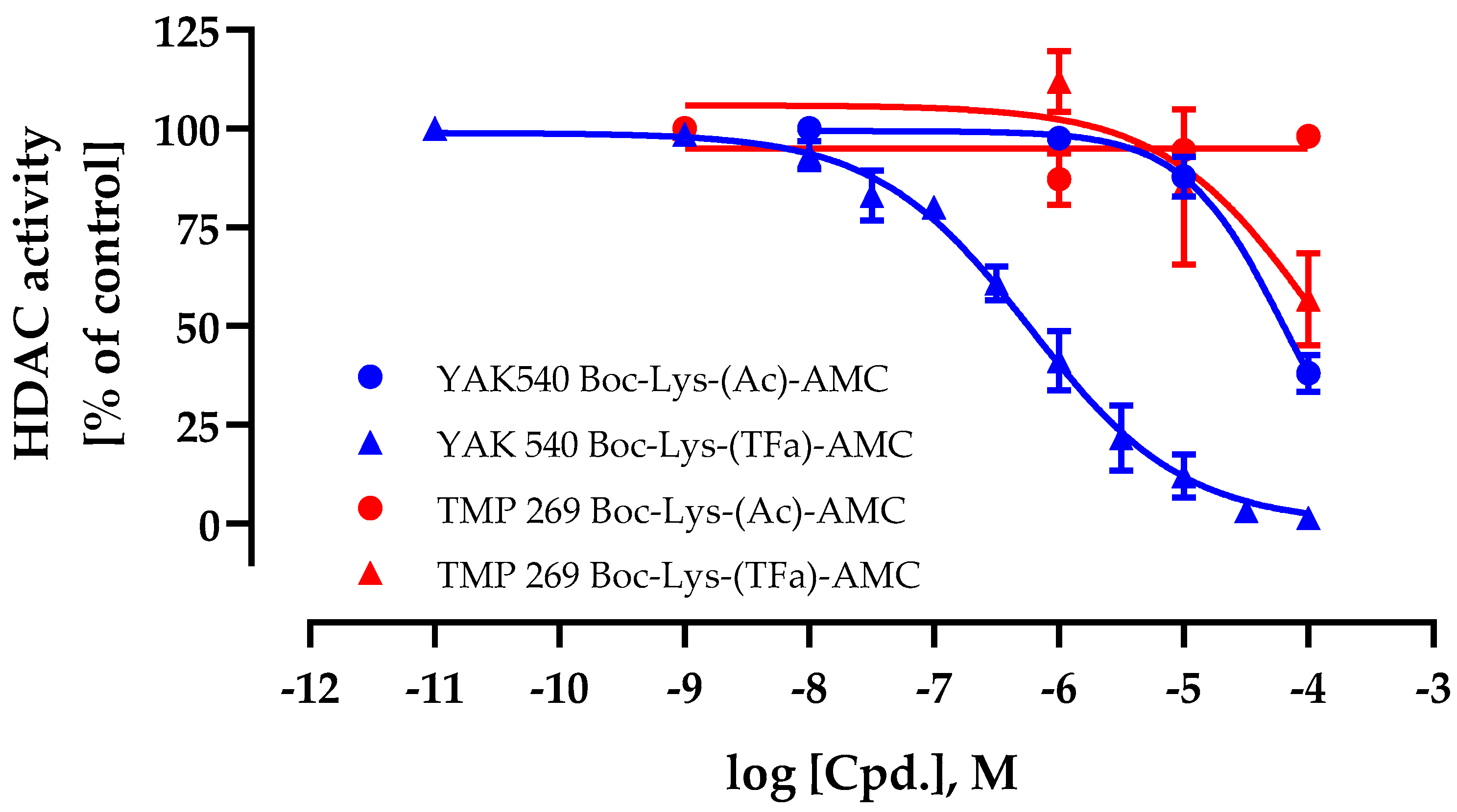


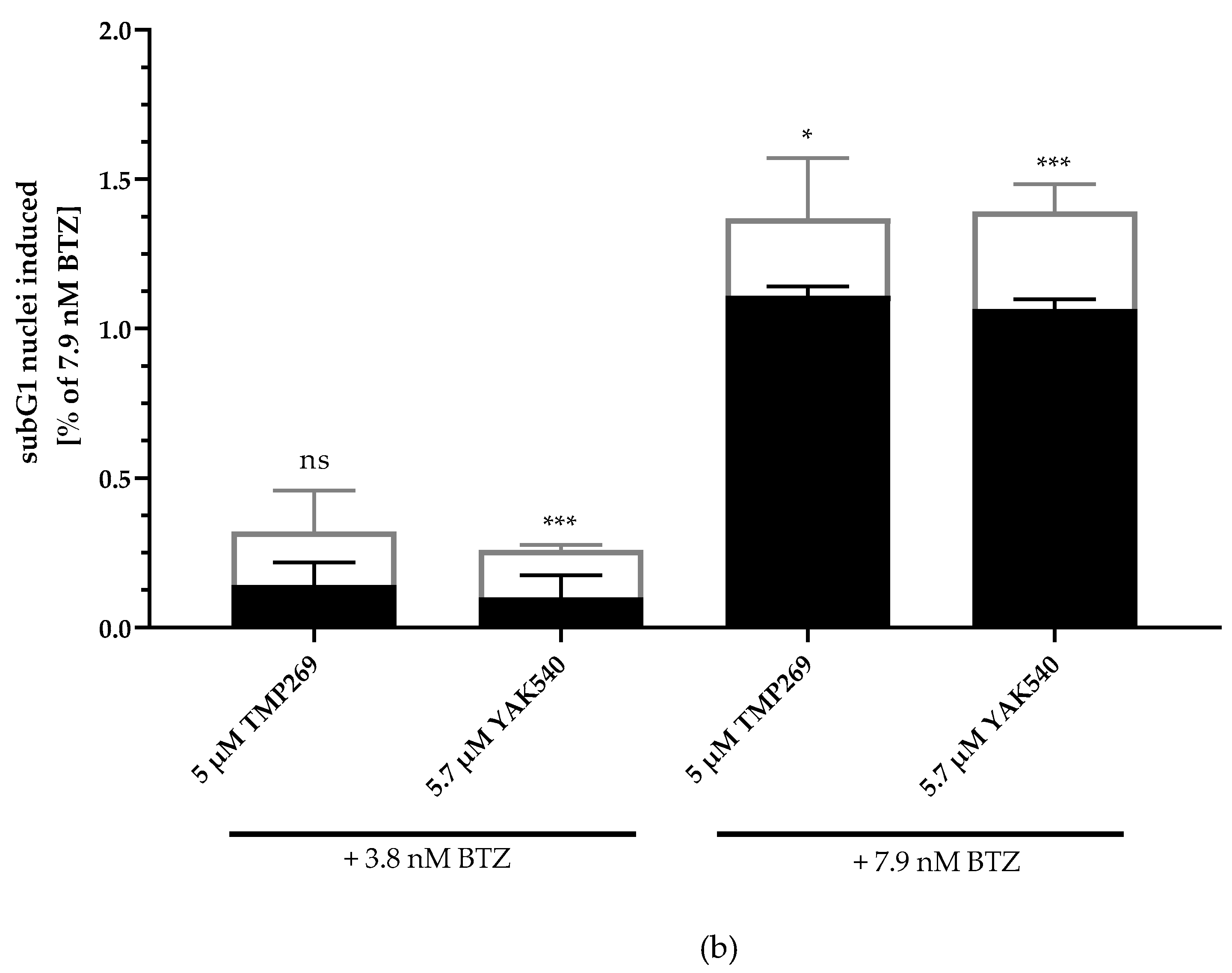

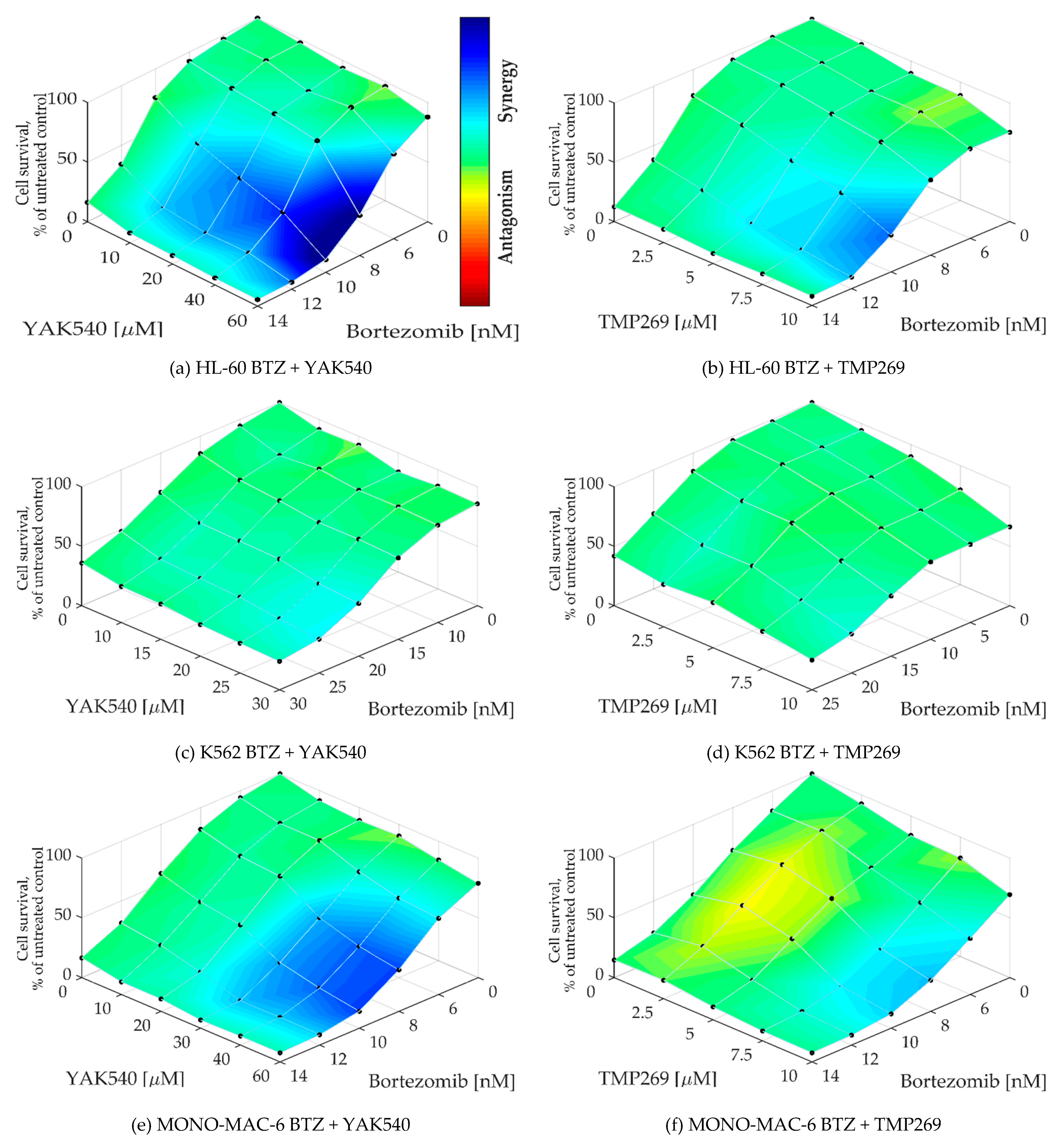



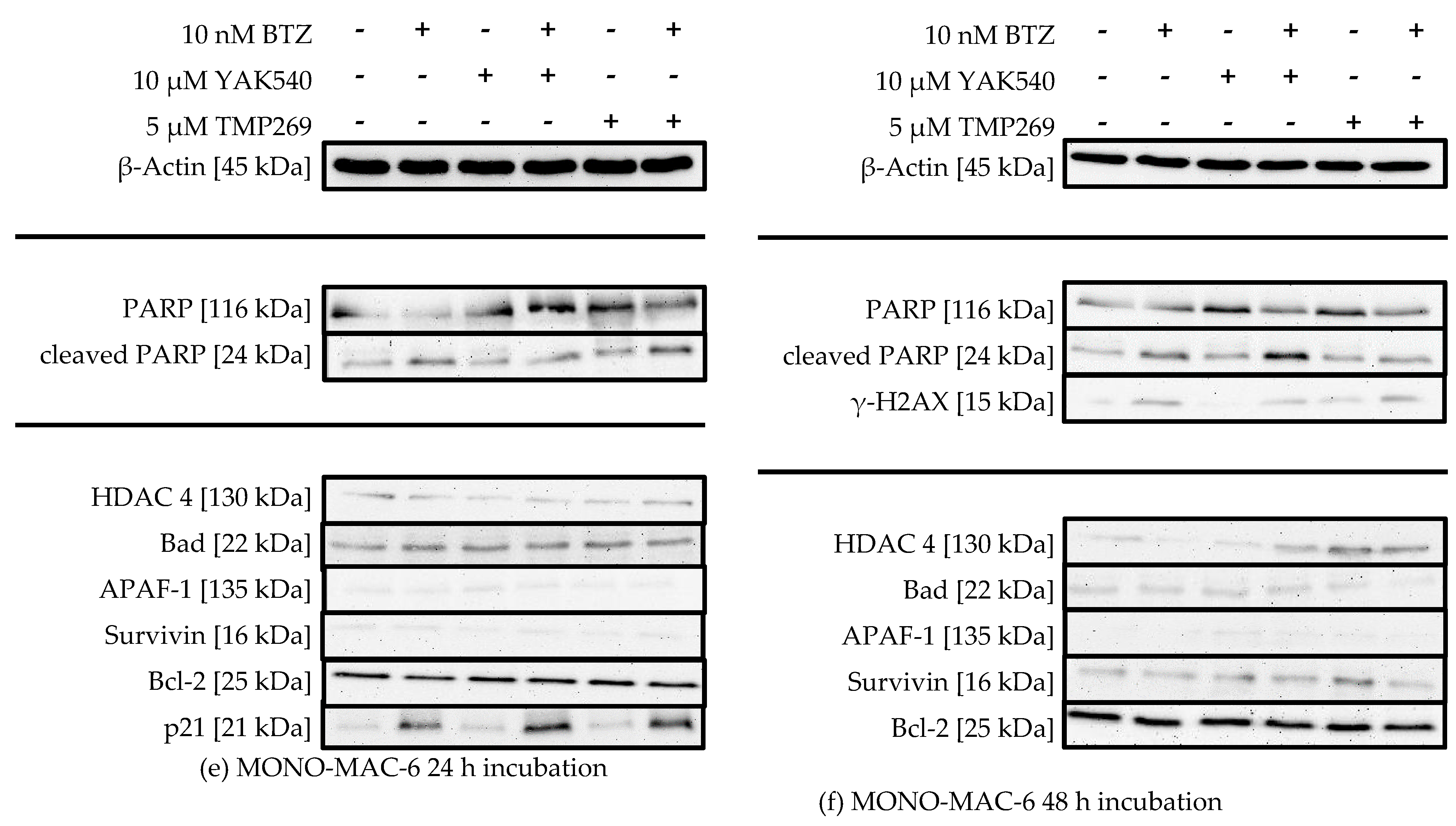
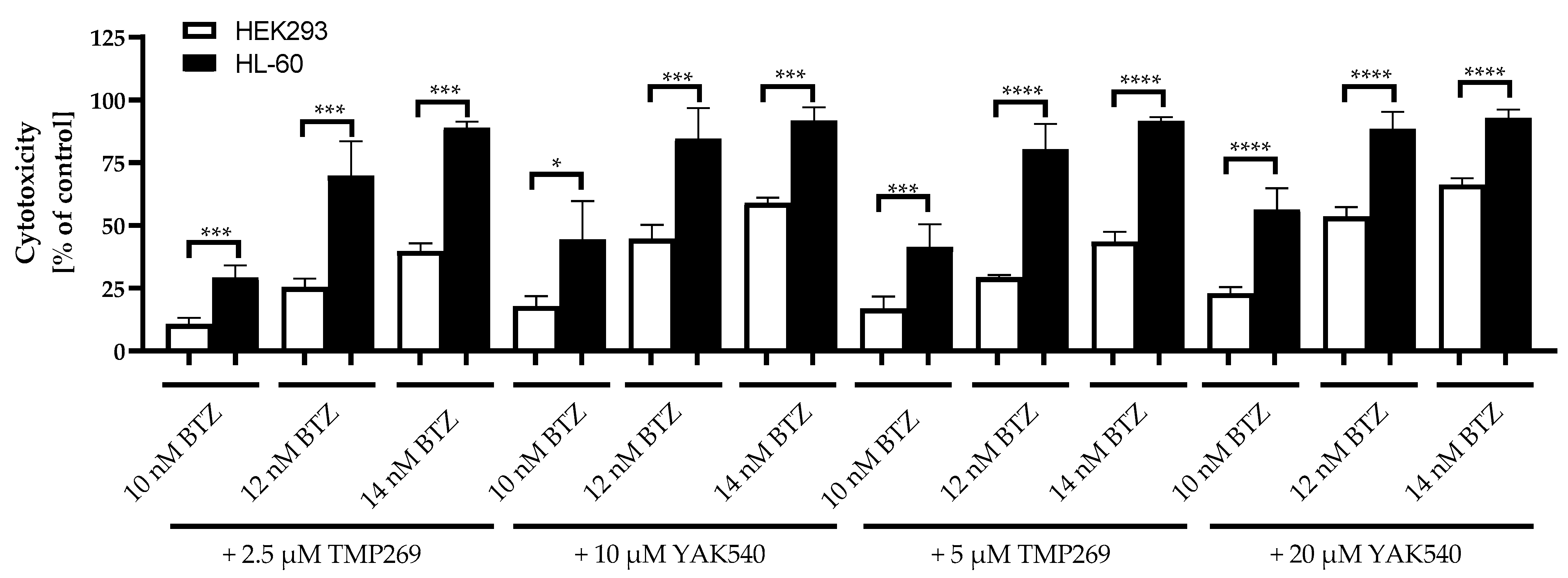
| YAK540 | TMP269 * | |||
|---|---|---|---|---|
| HDAC Enzyme | IC50 (pIC50 ±SEM) [µM] | Selectivity Index to HDAC 4 | IC50 [µM] | Selectivity Index to HDAC 4 |
| HDAC 2 | 30.2 (4.52 ± 0.03) | 265 | >100 | >637 |
| HDAC 4 | 0.114 (6.95 ± 0.03) | 1 | 0.157 | 1 |
| HDAC 6 | 11.4 (4.94 ± 0.12) | 100 | 8.2 | 52 |
| HDAC 8 | 9.39 (5.03 ± 0.03) | 82 | 4.2 | 27 |
| Cell Line | Bortezomib IC50 pIC50 ± SEM [nM] | YAK540IC 50 pIC50 ±SEM [µM] | TMP269IC 50 pIC50 ± SEM [µM] |
|---|---|---|---|
| HL-60 | 10.7 7.97 ± 0.006 | > 100 | 16.7 4.78 ± 0.016 |
| K562 | 20.9 7.68 ± 0.014 | > 100 | 23.0 4.64 ± 0.024 |
| MONO-MAC-6 | 12.4 7.91 ± 0.012 | 91.4 4.04 ± 0.022 | 15.9 4.80 ± 0.023 |
| THP-1 | 6.28 8.20 ± 0.020 | > 100 | 13.0 4.89 ± 0.035 |
| BTZ [nM] | YAK540 [µM] | TMP269 [µM] | ||||||||
|---|---|---|---|---|---|---|---|---|---|---|
| 10 | 20 | 40 | 60 | 2.5 | 5 | 7.5 | 10 | |||
| HL-60 | 8 | ○ | ○ | 3.43 | 0.512 | ○ | ○ | 2.82 | 1.84 | |
| 10 | 1.11 | 0.791 | 0.576 | 0.188 | 1.96 | 1.47 | 1.22 | 0.744 | ||
| 12 | 0.301 | 0.237 | 0.260 | 0.136 | 0.631 | 0.451 | 0.386 | 0.279 | ||
| 14 | 0.206 | 0.185 | 0.158 | 0.150 | 0.286 | 0.244 | 0.275 | 0.260 | ||
| BTZ [nM] | YAK540 [µM] | TMP269 [µM] | ||||||||
| 10 | 15 | 20 | 25 | 30 | 2.5 | 5 | 7.5 | 10 | ||
| K562 | 15 | 1.58 | 1.43 | 1.21 | 1.27 | 1.22 | 1.53 | 1.64 | 1.14 | 0.902 |
| 20 | 0.920 | 0.900 | 0.883 | 0.727 | 0.677 | 0.957 | 1.05 | 0.836 | 0.675 | |
| 25 | 0.706 | 0.668 | 0.636 | 0.557 | 0.507 | 0.690 | 0.801 | 0.708 | 0.615 | |
| 30 | 0.646 | 0.630 | 0.566 | 0.536 | 0.512 | n.p. | n.p. | n.p. | n.p. | |
| BTZ [nM] | YAK540 [µM] | TMP269 [µM] | ||||||||
| 10 | 20 | 30 | 40 | 60 | 2.5 | 5 | 7.5 | 10 | ||
| MONO-MAC-6 | 6 | ○ | ○ | 1.98 | 1.42 | 1.47 | ○ | 1.41 | 1.09 | 0.859 |
| 8 | 1.72 | 1.69 | 0.694 | 0.476 | 0.416 | 1.45 | 1.09 | 0.560 | 0.480 | |
| 10 | 0.670 | 0.579 | 0.265 | 0.174 | 0.124 | 0.764 | 0.622 | 0.298 | 0.259 | |
| 12 | 0.277 | 0.177 | 0.070 | 0.075 | 0.075 | 0.385 | 0.290 | 0.203 | 0.205 | |
| 14 | 0.094 | 0.095 | 0.060 | 0.069 | 0.073 | 0.198 | 0.179 | 0.177 | 0.202 | |
| BTZ [nM] | YAK540 [µM] | TMP269 [µM] | ||||||||
| 10 | 15 | 20 | 25 | 30 | 35 | 7.5 | 10 | 12.5 | ||
| THP-1 | 5 | 1.62 | 1.42 | 1.74 | 1.35 | 1.47 | 1.34 | 1.07 | 0.93 | 0.95 |
| 10 | 0.92 | 0.62 | 0.81 | 0.67 | 0.73 | 0.73 | 1.00 | 1.46 | 0.86 | |
| 15 | 1.24 | 0.79 | 1.11 | 0.61 | 0.73 | 0.59 | 0.75 | 0.79 | 0.67 | |
| Cell Line | Bortezomib IC50 pIC50 ± SEM [nM] | YAK540 IC50 pIC50 ±SEM [µM] | TMP269 IC50 pIC50 ± SEM [µM] |
|---|---|---|---|
| HEK293 | 11.8 7.93 ± 0.014 | > 100 | 32.8 4.49 ± 0.025 |
| Gene | Primer Forward | Primer Reverse |
|---|---|---|
| APAF1 | AGTGGAATAACTTCGTATGTAAGGA | AAACAACTGGCCTCTGTGGT |
| BAD | TTGTGGACTCCTTTAAGAAGG | CACCAGGACTGGAAGACTCG |
| BAK | TCATCGGGGACGACATCAAC | CAAACAGGCTGGTGGCAATC |
| BCL2 | GATAACGGAGGCTGGGATGC | TCACTTGTGGCCCAGATAGG |
| Survivin | TGAGAACGAGCCAGACTTGG | TGTTCCTCTATGGGGTCGTCA |
| FOXO1 | ATGTGTTGCCCAACCAAAGC | AGTGTAACCTGCTCACTAACCC |
| FOXO3a | AAGGATCACTGAGGAAGGG | GTGTCAGTTTGAGGGTCTGC |
| GUSB | ACCTCCAAGTATCCCAAGGGT | GTCTTGCTCCACGCTGGT |
| HDAC4 | TTGGATGTCACAGACTCCGC | CCTTCTCGTGCCACAAGTCT |
| HPRT1 | CCTGGCGTCGTGATTAGTGA | CGAGCAAGACGTTCAGTCCT |
| MCL1 | GTTAAACAAAGAGGCTGGGATGG | AGCAGCACATTCCTGATGCC |
| PTEN | ACTTGCAATCCTCAGTTTGTGG | TCGTGTGGGTCCTGAATTGG |
| TBP | GTGACCCAGCATCACTGTTTC | GAGCATCTCCAGCACACTCT |
| p53 | AGTCAGATCCTAGCGTCG | TCAGGAAGTAGTTTCCATAGG |
| Bcl-xL | CAGTAAAGCAAGCGCTGAGG | CCACAAAAGTATCCTGTTCAAAGC |
| Bim | AGACAGAGCCACAAGCTTCC | CAATACGCCGCAACTCTTGG |
| p21 | TGCCGAAGTCAGTTCCTTGT | GTTCTGACATGGCGCCTCC |
| XIAP | TTGGAAGCCCAGTGAAGACC | CAGATATTTGCACCCTGGATACC |
Publisher’s Note: MDPI stays neutral with regard to jurisdictional claims in published maps and institutional affiliations. |
© 2022 by the authors. Licensee MDPI, Basel, Switzerland. This article is an open access article distributed under the terms and conditions of the Creative Commons Attribution (CC BY) license (https://creativecommons.org/licenses/by/4.0/).
Share and Cite
Bollmann, L.M.; Skerhut, A.J.; Asfaha, Y.; Horstick, N.; Hanenberg, H.; Hamacher, A.; Kurz, T.; Kassack, M.U. The Novel Class IIa Selective Histone Deacetylase Inhibitor YAK540 Is Synergistic with Bortezomib in Leukemia Cell Lines. Int. J. Mol. Sci. 2022, 23, 13398. https://doi.org/10.3390/ijms232113398
Bollmann LM, Skerhut AJ, Asfaha Y, Horstick N, Hanenberg H, Hamacher A, Kurz T, Kassack MU. The Novel Class IIa Selective Histone Deacetylase Inhibitor YAK540 Is Synergistic with Bortezomib in Leukemia Cell Lines. International Journal of Molecular Sciences. 2022; 23(21):13398. https://doi.org/10.3390/ijms232113398
Chicago/Turabian StyleBollmann, Lukas M., Alexander J. Skerhut, Yodita Asfaha, Nadine Horstick, Helmut Hanenberg, Alexandra Hamacher, Thomas Kurz, and Matthias U. Kassack. 2022. "The Novel Class IIa Selective Histone Deacetylase Inhibitor YAK540 Is Synergistic with Bortezomib in Leukemia Cell Lines" International Journal of Molecular Sciences 23, no. 21: 13398. https://doi.org/10.3390/ijms232113398
APA StyleBollmann, L. M., Skerhut, A. J., Asfaha, Y., Horstick, N., Hanenberg, H., Hamacher, A., Kurz, T., & Kassack, M. U. (2022). The Novel Class IIa Selective Histone Deacetylase Inhibitor YAK540 Is Synergistic with Bortezomib in Leukemia Cell Lines. International Journal of Molecular Sciences, 23(21), 13398. https://doi.org/10.3390/ijms232113398






